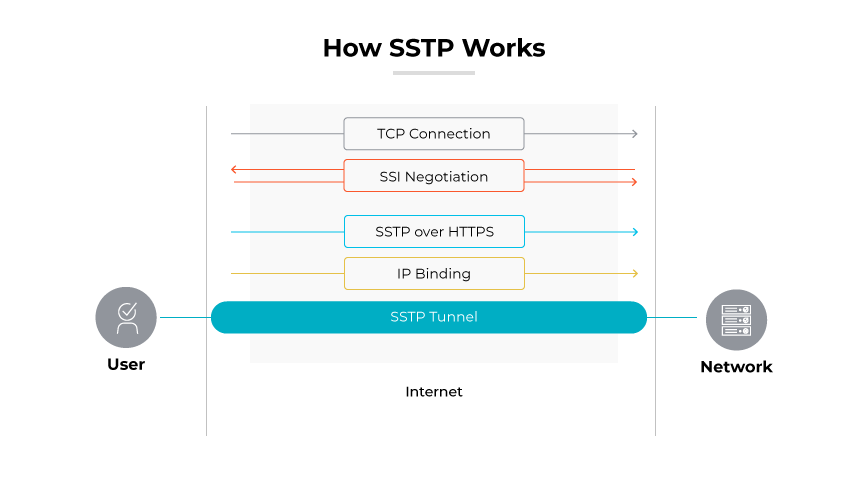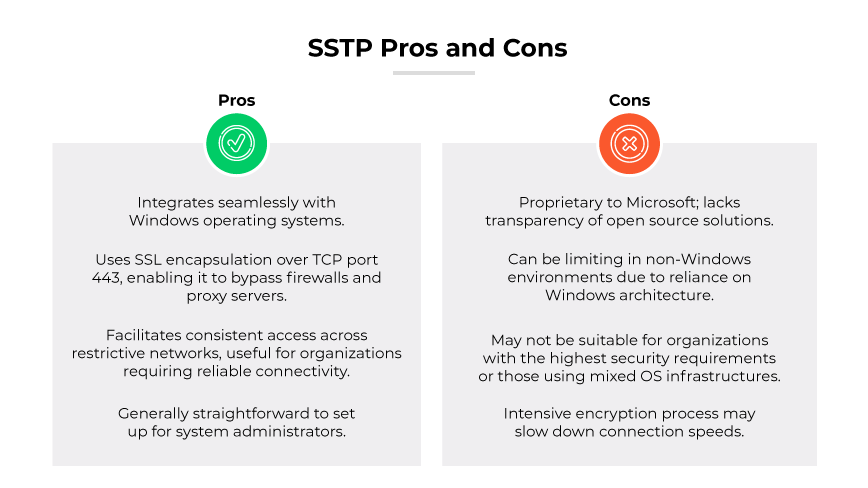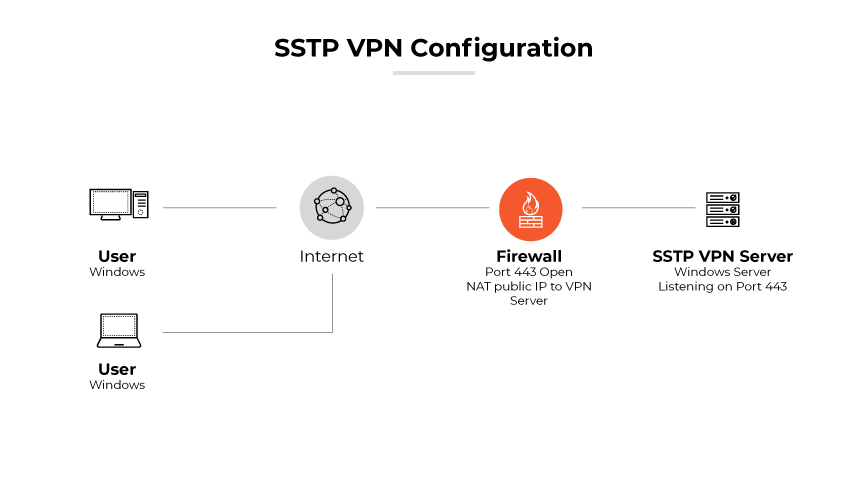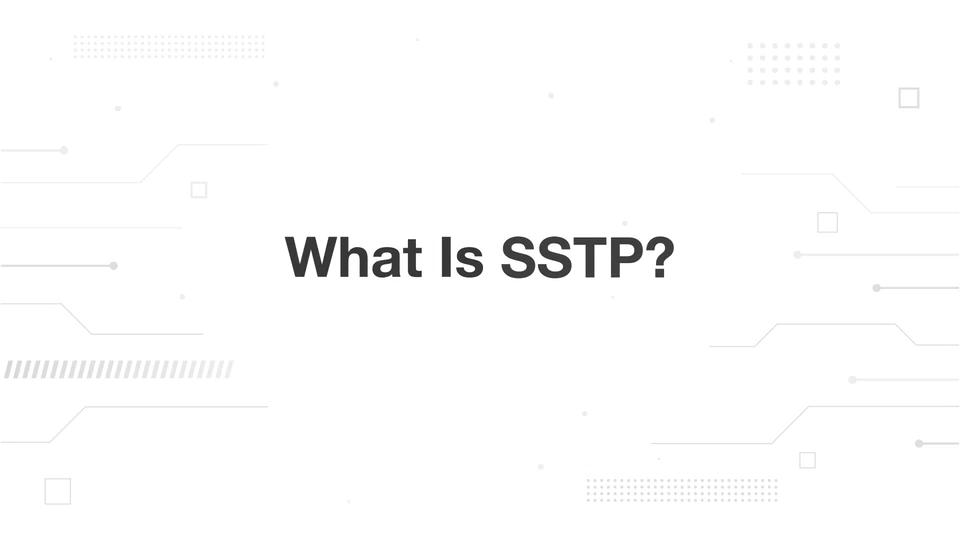What Is SSTP (Secure Socket Tunneling Protocol)?
SSTP is a VPN protocol that enables secure communication over networks by encrypting traffic as it tunnels through the internet.
SSTP (Secure Socket Tunneling Protocol) secures data with SSL/TLS encryption, which allows it to pass through firewalls effectively. SSTP uses the same port as HTTPS, ensuring compatibility and ease of access over the internet. The protocol enables secure, dependable remote access while protecting data privacy and integrity.
How Does SSTP Work?

SSTP works by establishing a secure, encrypted connection between a VPN client and an SSTP server. It uses well established protocols and ports to ensure security and accessibility.
Secure Socket Tunneling Protocol (SSTP) is a form of virtual private network (VPN) tunnel that provides a mechanism to transport PPP traffic through an SSL/TLS channel. SSL (Secure Socket Layer) provides transport level security with key negotiation, encryption, and traffic integrity checking. The use of TCP port 443 for traffic transmission allows SSTP to pass through most firewalls and proxy servers seamlessly.
SSL makes the operation of an SSTP server highly secure. The protocol encapsulates PPP packets over an SSL channel, enhancing security through the mechanisms of SSL/TLS. The initial phase involves a handshake process to establish a secure connection between the client and server. During this phase, the server is authenticated to the client using SSL certificates. After the handshake, encrypted PPP packets are transmitted through the established SSL channel.
SSTP uses the strong encryption and authentication features of SSL/TLS, enabling it to provide a secure, reliable VPN connection. The protocol is particularly effective in environments where VPN connections might be blocked or fail to connect through firewalls or NAT devices. The encapsulation of PPP packets over the SSL channel means that the protocol can traverse most firewalls since this traffic will appear similar to regular HTTPS traffic.
How Secure Is SSTP?
The Secure Socket Tunneling Protocol is regarded for its robust security features.
The protocol applies the Secure Socket Layer (SSL) encryption framework. SSL allows the protocol to create an encrypted bridge between the client and the VPN server, which ensures all data transmitted is inaccessible to unauthorized parties.
The Secure Socket Tunneling Protocol uses 256-bit AES encryption, often endorsed by cryptography experts as among the strongest encryption methods available. The encryption secures the tunnel at both ends with certificates that validate connection authenticity, guarding against interception and eavesdropping. Data integrity is maintained throughout the transmission process, making SSTP a trusted protocol for sensitive enterprise operations.
The choice of TCP port 443 for traffic offers stealth advantages. TCP port 443 is the same port used by regular HTTPS traffic, making VPN traffic indistinguishable from normal secure web browsing. This similarity allows the protocol to bypass network restrictions and firewalls.
While the protocol is predominantly geared towards Windows platforms, security benefits are extendable with proper configuration to other operating systems.
Secure Socket Tunneling Protocol Pros and Cons

SSTP Pros and Cons |
|
Pros |
Cons |
Integrates seamlessly with Windows operating systems. |
Proprietary to Microsoft; lacks transparency of open source solutions. |
Uses SSL encapsulation over TCP port 443, enabling it to bypass firewalls and proxy servers. |
Can be limiting in non-Windows environments due to reliance on Windows architecture. |
Facilitates consistent access across restrictive networks, useful for organizations requiring reliable connectivity. |
Intensive encryption process may slow down connection speeds. |
Generally straightforward to set up for system administrators. |
May not be suitable for organizations with the highest security requirements or those using mixed OS infrastructures. |
Secure Socket Tunneling Protocol is recognized for its Windows integration and the ability to create a secure VPN connection. The use of SSL encapsulation over TCP port 443 is a primary advantage, enabling SSTP to pass through firewalls and proxy servers that would typically block VPN traffic. This makes it an option for organizations that require consistent access across restrictive networks. Ease of configuration on compatible platforms makes setup generally straightforward for system administrators.
While the protocol offers several advantages, it is not without potential drawbacks. Being a proprietary protocol developed by Microsoft, it does not offer the transparency of open source solutions. Reliance on Windows architecture can limit utility in diverse environments that use a variety of operating systems. While security is robust, the intensive encryption process can result in slower connection speeds compared to less secure protocols.
The protocol’s strength is its seamless operation within the familiar terrain of Windows systems. For broader application across different operating systems, limitations can arise. The protocol's performance and security make it suitable for many applications. However, Secure Socket Tunneling Protocol may not meet the needs of organizations with high security requirements or operating on a mixed OS infrastructure.
What Is an SSTP VPN?

An SSTP VPN utilizes the Secure Socket Tunneling Protocol to create a secure connection between a VPN client and server. This type of VPN is particularly adept at transmitting data securely over networks that are typically restrictive or heavily monitored.
By leveraging the SSL/TLS encryption that underpins secure web transactions, an SSTP VPN ensures all data packets are encrypted and authenticated, providing a high level of security for enterprise remote access.
An SSTP VPN is a reliable choice for enterprises looking for secure, remote connectivity solutions. While it is especially convenient for Windows users, its robust security measures are applicable across a range of network scenarios where data protection is a critical concern.
Comparing Secure Socket Tunneling Protocol with Other Protocols
SSTP vs. OpenVPN
Secure Socket Tunneling Protocol and OpenVPN both employ robust encryption methods, enhancing their security profiles. SSTP, a proprietary Microsoft protocol, benefits from native Windows integration but lacks the transparency of OpenVPN's open source model. OpenVPN's use of both UDP and TCP translates to enhanced speed, a feature where SSTP, limited to TCP, may not perform as well. OpenVPN's extensive platform support surpasses Secure Socket Tunneling Protocol’s, which is mostly confined to Windows and a select few others.
Firewall traversal is a shared strength, with both using port 443, though SSTP's lack of support for authenticated web proxies could pose a detectable risk in certain network configurations. OpenVPN's "float" command may offer superior stability during network switches, an area where Secure Socket Tunneling Protocol’s resilience is less certain.
SSTP vs. IPSec
The security provided by SSTP and IPSec is generally strong. The complexity of configuring IPSec correctly can introduce vulnerabilities. IPSec's compatibility extends beyond Secure Socket Tunneling Protocol’s, with support for various platforms including macOS and certain Unix based systems. However, unidentifiable traffic patterns make IPSec more susceptible to firewall blocking, a limitation Secure Socket Tunneling Protocol sidesteps with HTTPS mimicry.
Speed considerations lean in SSTP's favor, as IPSec's negotiation for VPN tunnels is typically more time consuming, potentially impacting performance. While both protocols have their merits, Secure Socket Tunneling Protocol's seamless Windows integration and resistance to firewall interference make it a formidable choice within its operational domain.
SSTP vs. L2TP/IPSec
Secure Socket Tunneling Protocol offers a higher security assurance than L2TP/IPSec, partly because of its resistance to firewall detection, utilizing port 443. L2TP/IPSec, while established and broadly supported across platforms, falters with its double encapsulation process, which could slow down connection speeds and consume more resources. The broad platform support of L2TP/IPSec does not outweigh Secure Socket Tunneling Protocol’s advanced security features, making SSTP the preferred option within its native environment.
SSTP vs. IKEv2/IPsec
Comparing SSTP to IKEv2/IPsec reveals similarities in security levels, with both providing robust protection. The collaborative development by Microsoft and Cisco lends it an edge in perceived trustworthiness over the Microsoft centric Secure Socket Tunneling Protocol. Trust is further bolstered by IKEv2's open source variants.
Although both protocols offer limited cross platform support, IKEv2/IPsec extends to iOS, macOS, and BlackBerry. The speed and stability of IKEv2/IPsec may outpace Secure Socket Tunneling Protocol, because of its use of UDP and the MOBIKE feature, which maintains connections during network changes. However, SSTP's utilization of TCP port 443 for traffic makes it less susceptible to blocking compared to IKEv2/IPsec's reliance on UDP port 500.
SSTP vs. PPTP
Secure Socket Tunneling Protocol notably outperforms PPTP in security, offering enhanced encryption and a more solid protection framework. PPTP's vulnerabilities are well documented, contrasting with Secure Socket Tunneling's support for stronger encryption standards.
PPTP's main advantage is its legacy of wide platform support and ease of setup. However, its speed, attributable to weaker encryption, does not compensate for the security breaches it may invite. SSTP's use of port 443 makes it less prone to blocking by ISPs, reinforcing its position as a more secure, reliable option in a network where data protection is paramount.
SSTP vs. WireGuard
Secure Socket Tunneling Protocol and WireGuard are both competent protocols ensuring data security. WireGuard distinguishes itself with its modern, lightweight design which contributes to high speed performance and minimal resource usage. It is an open source protocol, which can be viewed as synonymous with enhanced trust because of public scrutiny and a collaborative development process.
With its integration into Windows, Secure Socket Tunneling Protocol provides a reliable solution for users within that ecosystem. Its use of TCP port 443 grants it a stealth advantage, making it more challenging for network administrators to block without disrupting other essential services. While WireGuard operates on a multitude of ports and is versatile across different platforms, including macOS and iOS, it could potentially be easier to restrict given its use of UDP.
WireGuard offers a modern approach with potential speed and privacy advantages, while Secure Socket Tunneling Protocol provides a tried and tested solution, particularly within Windows based enterprise environments.
SSTP vs. SoftEther
SoftEther is distinguished by its open source status, which can be perceived as especially trustworthy as a result of community vetting and contribution. This contrasts with Secure Socket Tunneling Protocol’s proprietary nature as a Microsoft developed protocol.
SoftEther is designed with versatility and speed in mind, boasting a claim of faster throughput compared to many protocols. While Secure Socket Tunneling Protocol is embedded within Windows, SoftEther requires additional steps for installation and configuration. Nevertheless, SoftEther compensates for this with compatibility across a broader range of platforms, including Linux, macOS, and various Unix based systems.
In terms of network flexibility, SoftEther has an advantage. It can traverse NATs and firewalls more efficiently because of resistance to network changes. SoftEther's server capability to support Secure Socket Tunneling Protocol as one of the multiple protocols it can run concurrently further underscores its flexibility.
For environments that prioritize extensive platform support and rapid data transmission, SoftEther may be preferable. SSTP remains a strong candidate within Windows oriented infrastructures.
